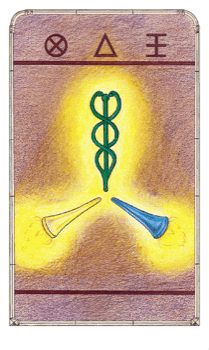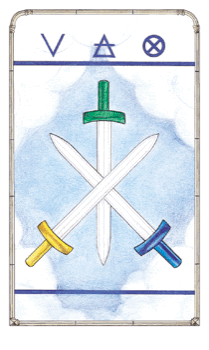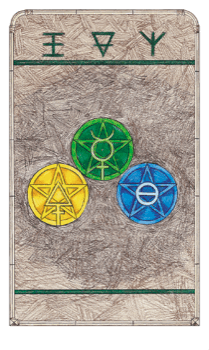 Send
comments about this page
Send
comments about this page Last update: 6 Sep 2022
The Active Triad is also the Principle of Mediation, which creates a Mean between the Extremes of the Passive Dyad, thus producing the Passive Triad, which is a Harmonia (Joining), a structured unity, the Rebis (Two-thing), a synthesis of the opposites (Coniunctio oppositorum) of the Dyad. This is the Alchemical Wedding, in which the alchemical Mercury (Triad) unites the alchemical Sulphur (Monad) with the alchemical Salt (Dyad); the result is the Living Gold or Philosophers' Stone.
The Triad corresponds to the Second Cosmological Stage in which some Active Agent (e.g. Eros) causes Earth and Sky to mate; thus was Enlil born of An and Ki; He is the Air, which fills the Gap between Heaven (An) and Earth (Ki); He establishes the Bond of Heaven and Earth (Dur-An-Ki).
In summary, the Active Triad is the principle of initial completion, joining, mediation, synthesis, compromise, moderation and unification.




Image: A caduceus between and above two inverted flaming torches form an inverted Y (yellow torch on left, light blue on right, green caduceus in middle).
Commentary: The inverted Y suggests the instability of the Threes, which will be corrected in the Fours. Blue and yellow are complementary colors, which are reconciled in green (= blue + yellow). The third wand is the caduceus of Mercury, who is the reconciler and leads us across boundaries. Likewise, among the Three Principles of alchemy (sulphur, salt and mercury), mercury unites the other two. As the yellow and blue torches are associated with fire and water, respectively, so the green caduceus is associated with air (the element through which Mercury flies). Air (which is wet and hot) combines the (blue) moisture of water (which is cold and wet) with the (yellow) heat of fire (which is hot and dry), and thus reconciles their opposition by combining their powers. By combining blue and yellow, green symbolizes the unification of heaven and earth in mysticism, and of cool intellect and warm feeling in wisdom and hope (Cooper s.v. Colors), but green is also the color of inexperience (Biedermann s.v. colors).
In intellectual realms the Trey of Swords can simply represent the initial completion of some analysis, that is, of some discriminating or judgmental process. This accomplishment is often followed by overconfidence in one's conclusions and the feeling that one has all the answers, and that they're unassailable because they've been "proven by logic." As a consequence, opinions harden and arguments can become vicious as intellectual antagonists begin to doubt their opponents' honesty or motives. In general, winning the battle may be mistaken for winning the war.
Image: Two upright swords crossed over a third, inverted sword; yellow hilt on left, blue on right, green in middle; all on a background of clouds.
Commentary: The crossed swords show the engagement in strife. The third sword, inverted like a dagger, suggests treachery. This, plus the obscuring background of clouds, suggests that victories are less secure than they seem. Since the opposed swords are crossed over the green sword, the image suggests the current situation (including any apparent victory or resolution) is still within the shadow of conflict.
The Trey of Cups can also represent the successful re-establishment of a relationship that had previously disintegrated. Thus, reconciliation, emotional healing, resolution of differences.
Image: Two cups (yellow on left, blue on right) pour their contents into a third, green cup in the middle below them. A golden fluid comes from the yellow cup, a silver fluid from the blue. The background is dark blue.
Commentary: The third cup mediates the relationship between the other two, which pour out into the relationship the unique gifts they have to offer. The third cup is below the other two, which gives a more stable configuration than that of the Threes of the other suits.
Image: A green pentacle is supported by a yellow pentacle (left) and a blue pentacle (right) in an inverted V formation on a dark brown background. The pentacles are engraved with the alchemical symbols for sulphur (yellow), salt (blue) and quicksilver (green).
Commentary: The green pentacle represents success, but its high position is not supported securely, so the victory is not secure. As indicated by there symbols, the pentacles represent the Three Principles of alchemy (quicksilver being the mediator that joins the salt and sulphur). The green color suggests comfortable material prosperity. The dark brown background represents the fertile earth.
 Send
comments about this page
Send
comments about this page
Last update:
6 Sep 2022